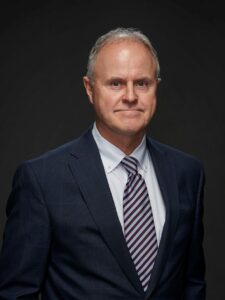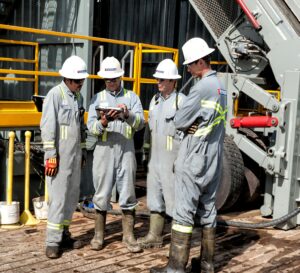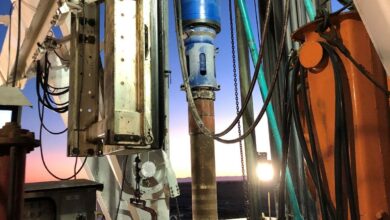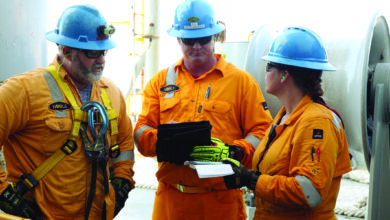Geddes: Too many still don’t know where energy comes from

Industry must dispel common erroneous beliefs, position itself as solution provider in the energy transition, 2021 IADC Chairman says
By Linda Hsieh, Editor & Publisher
Some people join the drilling business for the adventure but leave once they realize that the technical challenges and the cyclical ups and downs are not for the faint of heart. And then there are people – like Bob Geddes – who find motivation in tough challenges, and whose love for the tightly knit drilling business overcomes any trepidation they might have about building a career in a boom-and-bust industry.
“It’s never a dull moment in this business,” said Mr Geddes, who serves as President and Chief Operating Officer for Ensign Energy Services and who was recently elected as 2021 Chairman of IADC. “Just when you think you’ve got it all figured out, something else happens.”

Mr Geddes didn’t have any specific exposure to the drilling industry in his childhood. However, he did get glimpses of the oil and gas business growing up in Edmonton, Alberta – a blue-collar town that is the location of multiple major refineries. He also had a connection to oil and gas through his father, an engineer who worked for a downstream-focused natural gas company.
“I worked at a refinery myself in the summer while I was in university and almost ended up in the refinery and pipeline business,” Mr Geddes recalled. However, once he completed his mechanical engineering degree from the University of Alberta in 1980, he decided to take a different route.
Mr Geddes went to work for National Oilwell, designing masts and subs at a time when the oil market was riding high and companies couldn’t build rigs fast enough. He estimates that National Oilwell built a whopping 80 rigs in Edmonton during those few years in the early ’80s.
Within a few years, however, the market crashed, and he got his first taste of what an oil bust feels like. It didn’t scare him into leaving the industry. In fact, he soon joined Brinkerhoff Drilling – a much smaller company than National Oilwell, to be sure, but one that allowed him to gain experience in multiple aspects of the drilling process. “I was a jack of all trades during the four or five years I was there,” he said.
To start with, Mr Geddes chose to spend his first winter with Brinkerhoff working on a drilling rig, driven by a desire to understand how rig crews worked and how the hole in the ground was created. “My previous job was all on the design side, so I knew it would be something I would always regret if I didn’t go out and actually work on a drilling rig. With engineering, it’s so important to get that field experience to understand not only the machine but also how the human interacts with it.”
By the early 1990s, Mr Geddes found himself ready for a new challenge when he was recruited by a newly re-capitalized company called Ensign. At the time, Ensign was a tiny company with only a few rigs to its name, but Mr Geddes decided to take a chance. He found himself among a team of people who believed in the future of the drilling business and who went all-in to build the company up. “We put every cent back into the company, and we made a lot of acquisitions,” he recalled of his first decade with the company. Between 1990 and 2000, Ensign made 63 acquisitions. More recently, it also acquired Rowan Land Drilling in 2011 and Trinidad Drilling in 2018. Today, Ensign operates 250 rigs around the globe, the vast majority of which are modern, AC-powered units.
The company wasn’t just focused on growing its size during this time. Just as importantly, it pushed forward on technical innovations like building self-moving pad rigs and installing portable top drives to enable horizontal drilling.

Since Mr Geddes took over his current role as President and COO in 2007, the company has further deepened its focus on in-house development of automation and digital technologies, like its proprietary Edge wellsite technology. “We’re probably one of the few companies that have built that type of technology from the ground up rather than purchasing it,” he said. The system encompasses controls, which address downhole challenges like stick-slip and bit dysfunction, and a suite of relevant applications to optimize different parts of the well construction process.
The company is also working on directional guidance systems, based on algorithms that mimic the actions of a top-performing driller and make them more repeatable and consistent across the company’s entire rig fleet. The result is a system that can accurately steer the bit out a couple of miles and end up within a couple of feet of the plan.
The next step, Mr Geddes said, is to take all the various components of automation and digitalization and string them together to function more cohesively as one. He compared this to an orchestra creating music: All the sections of the orchestra are in place – strings, percussion, woodwinds, brass – but we’ve not yet learned to produce music in a coordinated fashion.
“The maestro is the final step that everyone’s pulling together now, where we’ll have the combination of the automation, machine learning, predictive analytics, etc, so that we can manufacture wellbores in a predictable manner,” Mr Geddes said. “We’re on the cusp of playing brilliant music with all of our instruments, but the industry is not quite there yet.”
Achieving that level of automation – akin to the autopilot function on an airplane – was already a complex task to begin with, but now the pandemic and market crash have added new kinks into the process. As drilling contractors fight for their survival amid a downturn of historic proportions, they must be more selective than ever with new technology R&D and implementation.
To overcome this challenge and keep these investments going, Mr Geddes said the industry should look to performance-based contracts. In the past 10 years, he pointed out, the industry has learned to drill wells four times faster, which means drilling contractors’ invoices to operators are only one-quarter of what they once were. Performance-based contracts can help because they will encourage drilling contractors to continue investing in performance-enhancing technologies at a time when companies are being forced to cut costs to the bone.
For the operators, these types of contracts also make sense because the additional payments only kick in when the contractor delivers on certain metrics. This ensures that everyone sees returns on their investments. “I would suggest that three bids and a buy doesn’t always bring you the lowest-cost wellbore,” Mr Geddes said. “We need to move to a collaborative effort where companies can become more aligned and bring better technologies to the table.”

Another sticking point in recent years, as the industry makes increasing use of rig and well data, has been around data ownership. In fact, who owns what has become the subject of vigorous debate.
But Mr Geddes said he advocates for shifting the focus away from ownership. “I’ve always said the ownership of that data is irrelevant. What’s more important is the format and frequency of the data, the truth of the data, and whether we can use it in our algorithms and software to get the desired result. There’s a lot of shrouded secrecy around data at the well site, but I think we need to open that up.”
He notes that Ensign is close to working out data-sharing agreements with its clients, with several pilot programs ongoing around portals and bridge-sharing data. “Look at our autopilot program, for example. It’s continually getting tuned, just like a manufacturing business. A drilling rig is, in essence, a mobile manufacturing plant that puts holes in the ground. So let’s look at the data to see how we can help the client to further tune the wellbore delivery.”
2021 Chairmanship Goals
As IADC’s 2021 Chairman, Mr Geddes said he wants to ensure that the association continues to support educating the general public about energy issues. There are still too many misunderstandings about where energy comes from, such as believing that electricity is an energy source in itself. Dispelling these erroneous beliefs will require a collaborative effort by all parts of the oil and gas industry, including drilling contractors.
At the same time, the drilling industry must position itself as a solution provider in the energy transition and promote more transparency around drilling operations. This includes better messaging around the industry’s existing ESG efforts, like electric rigs and natural gas-powered rigs. “I know it’s hard to do, but as an industry we should be trying to change people’s historical thinking of what we do. Natural gas is going to be a big player for cost-effective electricity generation for some time to come. Even if everyone went to electric cars tomorrow, we’d need another 10 million barrels of oil and gas a day in order to produce that electricity. Everyone also wants it cost effectively.”
Safety is another area, Mr Geddes said, where the industry should continue to strive not only for zero incidents but also for better communication of our achievements. Despite all the improvements that have been made in the past decades to enhance drilling safety, the general public still widely perceives drilling rigs to be dangerous. “But it’s actually three times safer working on a drilling rig than driving to the drilling rig,” he noted. “We say, hurry up and get to the rig, where it’s safer than being out on the road. People don’t understand that, but we need to show them how amazingly safe rigs are today and that careers can still be built delivering cost-effective and emission-efficient energy to the world.” DC




